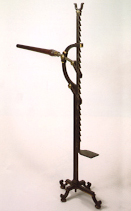
116 x 99.5 x 31.5
Iron, wood and brass
INDEX 1788 : F.III.126
Vectis compositus ex regula ferrea dentata, duobus uncis, Vecte primi generis, et pede ferreo, qui proprio nomine Vectis productus a Musschembroekio vocatur.
Lever composed of a toothed iron rod with two hooks, with a lever of the first kind and an iron stand, properly called "lever produced by Musschenbroek".
This machine, used to lift loads, is described in the French edition of Musschenbroek´s Introductio ad Philosophiam Naturalem, where it is called "levier prolongé". As can be seen in the reproduction of Musschenbroek's engraving, the lever proper is section BCA, moveable around point C, which has an axle at end A, with an iron arm, AD, moving around it, which grips the teeth of a vertical rod. When the weight to be lifted is placed on the platform, the lever is moved so that AD grips successive teeth. The lower clamp, HG, is to avoid the vertical rod falling when AD passes from one tooth to the next. The condition of equilibrium is that the magnitude of the force applied at the end B should relate to the weight of the load, at F, in the same way as the lever arm of the force (which is approximately equal to the distance from C to the bar, on the teeth side) relates to the distance CB. The whole machine is made of iron, except the handle which is made of wood and brass.
From Colégio dos Nobres, catalogue n.º 118.
Carvalho, Rómulo de, História do Gabinete de Física da Universidade de Coimbra, Universidade de Coimbra, Biblioteca Geral, Coimbra, 1978, p. 271.
Musschenbroek, Peter van, Introductio ad Philosophiam Naturalem, Leiden, 1762, §437, Tab. VI, Fig. 7.